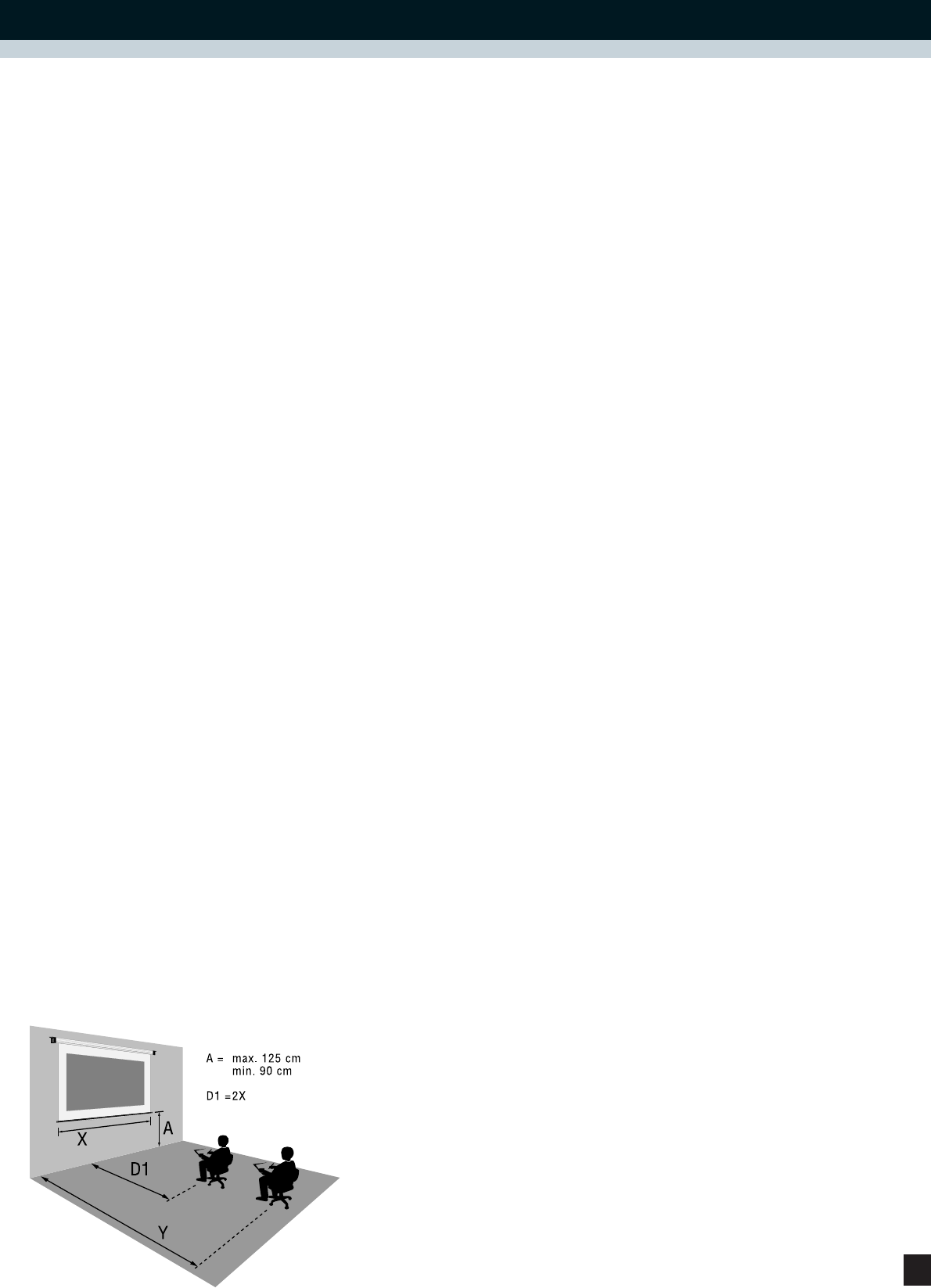
A. Trapezoid distortion
Front projections typically produce a trapezoid
distortion (keystoning). The projected picture is
larger at the top of the screen than at the bottom.
This distortion is caused by an inclined projec-
tion onto a straight hanging screen. Special key-
stone eliminators allow for an inclined positio-
ning of the screen to provide for an appropriate
means to avoid the trapezoid distortion when
using OHP. With the modern data and video pro-
jectors, the trapezoid effect can also be avoided
or reduced with the keystone eliminators.
B. Gain factor
The gain factor describes the luminance of a
fabric or a projection screen. The higher the gain,
the stronger the reflection of the screen fabric.
With an increasing gain factor, the viewing angle
of the screen decreases.
C. Angle of view
The angle of view describes the angle in degree
where the picture on the screen is still adequate-
ly visible. It is measured with reference to the
normal of the screen center. The double angle of
view (= viewing angle) thus describes the area
within which an audience should be seated.
D. Selecting the right screen
Selecting the right screen depends on four
variables:
1. Type of screen
■ Rear or front projection (the latter is the most
common method).
■ Mounted firmly or portable.
■ Operated electrically or manually.
2. Screen size
■ Depends on projection room and seating
arrangement.
■ IIdeally, the following criteria are considered:
•
The screen width (X) should amount to at
least half the distance between screen and
first row of seating (D1) (example: With a
distance of 4 metres between the first row
and screen, the minimum screen width is
2 metres).
•
The distance between screen and last row of
seating (Y) should not be larger than 6 times
the screen width (X) (example: With a screen
width of 2 metres, the last row should be at
12 metres as a maximum).
•
The distance between floor and bottom edge
of screen (A) is 90 cm, preferably 125 cm
for row seating.
3. Screen format
It is determined by the projection method. The
format (also referred to as aspect ratio) is
defined by the ratio of height to width of the
screen. Depending on the projection type, the
following formats are distinguished:
•
1:1 for overhead projection (also referred
to as square)
•
4:3 for video projection (also referred to
as NTSC or video)
•
3:2 for slide projection
•
16:9 for widescreen projection
4. Type of fabric
The type of fabric is determined by the following
factors:
■ The projection method (front projection
or rear projection).
■ The projector. Each projector has a specific
luminous efficacy (measured in ANSI lumen).
If several projection devices are used (e.g.
beamer and OHP), it is recommended to
match the luminance (gain factor) of the
fabric to the lowest ANSI lumen value.
■ The size of the projection room. The size and
the layout determine the seating of the
audience. The wider the seats are apart, the
larger the recommended viewing angle of the
screen.
■ The ambient light.
The lighting conditions of the projection envi-
ronment affect the presentation quality. When the
lighting can be controlled, e.g. by darkening or a
high luminance of the projector, the "SuperLux"
fabric can be used.
The rule of thumb is: keep the ambient light
away from the screen; the brighter the ambient
light, the higher the luminance of the projector
and/or reflection of the fabric should be.
Rear projection is substantially more insensi-
tive to ambient light!
E. Care of screens
Frequent use of a screen requires an appropriate
care. All screens can be cleaned with a carefully
applied weak soapsuds. When not in use, the
screens should be retracted to their casing to
protect them against depositing dust.
Avoid to touch the screen fabric with bare
hands since, in the course of time, dust will stick
better to the (greasy) imprints than on clean
spots.
HOW TO CHOOSE THE SUITABLE SCREEN
7


















